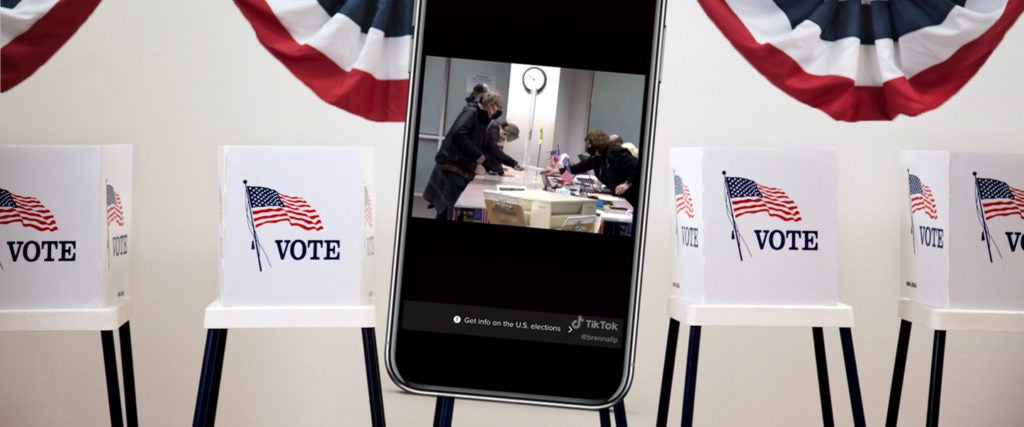After a momentous campaign to enact a “blue wave” in 2018, it was hard not to be disappointed in the 64 percent of 18- to 29-year-olds who did not vote in the midterm elections. In fairness, the youth turnout in 2018 was 20 percent higher than the last midterms in 2014, but for all the media attention and pleas from celebrities, it’s hard not to wonder why young voters consistently underperform at the polls.
Two years later, though, Ysiad Ferreiras, CEO of the political nonprofit Bigtent Creative, believes he’s found the solution: TikTok. “We’re getting crazy, phenomenal results on TikTok,” Ferreiras tells me. “Historically, breaking 10,000 registered voters is a huge milestone, and one you typically need a big budget to reach — because once you get there, it’s not unheard of to be spending at least $100 per registration.”
But in just 10 weeks, Bigtent is nearing 25,000 voter registrations, roughly half of which have come from TikTok (they’ve also tested similar voter-registration campaigns on Twitch, Snapchat, YouTube and Instagram). And they’re doing it a fraction of the normal cost. “We’re spending less than $20 per registration,” Ferreiras says. “And when I say $20, I’m including every single dollar that’s spent in my organization. I’m talking about the cost of us incorporating office supplies, Zoom subscriptions, everything — add all that up and it’s still under $20 per registration.”
@paradiisedd register to vote on my instagram story swipe up ! ig: paradiisedd
@theluncheonlawyer But if you have ✨empathy✨ link in bio. #kamalaharris #biden2020 #settleforbiden2020 #joebiden2020 #liberal #politicaltiktok #election #election2020
The lesson here: It’s not a matter of whether younger people want to vote, but a matter of reaching them where they’re at. “People wonder, ‘How come these people in the desert aren’t drinking water?’” Ferreiras says. “Well, it’s because there’s not much water there. Maybe put some water there, and they’ll drink the water.”
The water has been missing primarily because voter-registration efforts are almost always a few years behind the latest tech trends. “So what you end up with is people in their mid-20s, early-30s controlling spend and saying, ‘Let’s not make the mistake of not spending on Facebook this year,’” Ferreiras says. “This is great for reaching people in their age bracket, but by that time, they’re not 18 to 22 anymore, and that group is on a totally new platform.”
@jakehunterofficial So you gonna vote? ? Register with the link in my bio! @kianalbandi @jenfranco #tiktokfightsback #tiktokban #notmylastpost
Another problem is that there’s no data or analytics from that totally new platform that proves whether spending money to reach new voters there will pay off, so anyone in control of a campaign’s money will struggle to convince their bosses to try it. “You almost need an R&D budget to experiment and see what platforms work or not, which is what we did,” Ferreiras says. “I knew the people who are trying to register votes and the rest of the progressive movement wouldn’t be doing that, so if we didn’t try, it wouldn’t get done and these people would never be reached.”
That said, Ferreiras gives most of the credit to the TikTok creatives who make the videos. “They’re not just parroting what other people say, the creators come up with a lot of their own messaging because they’re passionate about this themselves,” he tells me.
@varsenex Safe the hotties!!! Go vote
“Everybody knows there’s a lot of money in politics,” Ferreiras continues. “We’re just trying to make it inclusive in terms of who gets the money by spreading it out among people who aren’t normally involved in the political process to organize their own communities.” And by putting the money that would otherwise go to shareholders who own social networks “directly in the hands of young people of color to organize their own communities means that more money goes toward making authentic, interesting content that resonates with their community and invites them to become voters.”
@marquaythegoat Let’s vote guys! Link in bio! @dyerisby you next #foryou
More than 15 million people have turned 18 since 2016, and by November, one in 10 eligible voters will be between the ages of 18 and 23. So as much as Bigtent has done, it’s really only getting started. “These things are working, but we need to do a lot more of it,” Ferreiras concludes. “The younger generation is hungry to take part, yet we’re still grossly underinvesting in the platforms where they live.”

